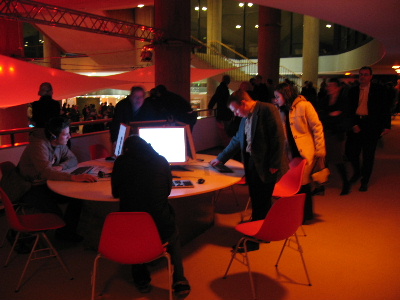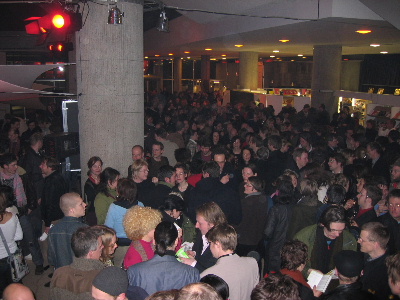|
Report From Transmediale.04: Fly Utopia! http://www.transmediale.de Jan 31 – Feb 4, 2004 Haus Der Culturen Der Welt Berlin, Germany |
 |
| In the backdrop of a snowy Berlin skyline, Transmediale.04 opened with a hefty line-up of theorists, performers, artists, and practitioners. Billed as the second largest media arts festival in Europe (next to Ars Electronica), the event featured award categories of Software, Interaction, and Image, and showcased a wide assortment of themes ranging from locative mobile media to social fictions to speculative programming and MIDI scrap-yard workshops. This year’s theme was “Fly Utopia,” perhaps a reaction to the idealistic vision of technology as a harbinger of the promised land of connected toasters and robot butlers. Instead of exhibiting nicely “packaged” products or projects, the festival aimed to add accountability to practice by focusing on social and political movements that question the status quo. Whether these themes were embodied in art objects or a way of thinking seemed less important than the overall message: creativity breeds disruption.
The opening ceremony discussions began with the idea of “utopia” as coined by Thomas Moore, specifying an ideal commonwealth whose inhabitants live under perfect conditions. Some participants argued that technology has augmented this definition, especially with the use and dissemination of the Internet, where the concept of “place” has lost meaning as a fixed location. This discussion generated questions throughout the festival, such as how historical visions of the future, especially those of technology, have kept us questioning our fate. |
 |
|
Beginning with the theme of bio-technological utopia, several projects and lectures presented a future consisting of everything from human-grown organs to planned and assisted ritualistic death. Designer Fiona Raby’s (RCA) former students presented their work within the context of “Immortality,” a sub-section of a larger inquiry entitled “Consuming Monsters.” Specific projects included the “Toy Communicator,” a telematic device to allow people to talk to their pets when they are away. Another piece, “Planned Death,” consisted of a kit for committing suicide when one reaches a state of physical perfection. All of these future products were on display in the Transmediale exhibition space as wary reminders of the future of our imperfection. Along similar lines was Shilpa Gupta’s “Your Kidney Supermarket,” an installation commenting on a bleak future of organ trading across national borders, consisting of several dozen kidneys in a hypothetical showroom. Despite its lack of noticeable technology, the project displayed how close we have come to commodification of anything (including human organs). Another interesting lecture was about constructing the national identity of the principality of SeaLand (sealandgov.com), a sovereign island micro nation situated in international waters, 6 miles from the coast of Britain. This identity overhaul included designing stamps with pictures of corporate scandals and failed political regimes, and coins made to look like writeable CD media.
One of the most heated conference debates occurred after Andreas Broegger’s talk “From Art as Software to Software as Art.” This presentation featured details of two influential art interventions from the 1970’s: Jack Burnham’s “Software” show at the Jewish Museum in NYC and the magazine “Radical Software.” Broegger’s aim was to show how a shift in attention has occurred away from simply taking art objects at face value and towards examining the processes and ideas they instill and execute. Arguments were vented that the 1970’s show was trying to appropriate a definition of the term “software” while today’s “software art” is more about utilizing and positioning the software as an art object unto itself. In this regard, the Radical Software magazine can be seen as distilling cultural processes into information processes as a type of software creation. I tend to think that today’s software art has an interest in not only what it represents as executable code, but also in how people use and experience it in their everyday lives. Since software was not a pervasive technology in the 70’s, this question of defining the term existed as artistic experiments and conceptual models of what the future of technology might hold. Today a glitchy network protocol can be called art, whereas the 1970’s birthed the idea that computational technology could be re-purposed for artistic interventions in the first place. |
 |
| Shilpa Gupta’s “Your Kidney Supermarket” on dislpay |
| Moving into mobile space, the MobiloTopia panel featured artists working with location-based or “locative” media. Marc Tuters opened the discussion with an overview of the “Locative Media Lab,” a dispersed network of practitioners focusing on the creative practice and use of portable, context-aware technologies. His talk featured a breakdown of the cultural theory and representative images of future utopias as envisioned from the past. Ben Russell followed by offering an overview of current systems for location tracking and surveillance. He presented a case for creating localized street level sharing systems, where for instance, people would be able to use their neighbors’ garden equipment if they knew it was available on a shared map. This idea would certainly work in a utopian version of the world, but may not be likely in today’s ultra paranoid, terrorist-alert police state. Drew Hemment of FutureSonic spoke about how locative media feeds into emergent art practice; whereby navigating real space is the impetus for the work (think GPS drawing). Finally, Teri Rueb showed documentation of her “Trace” project, an interactive, location-aware sound installation where hiking in a forest recalled sounds clips that commemorated personal loss.
The award presentations for image, interaction, and software consisted of short talks by the nominated artists. In the image category, Julien Maire’s “DEMI-PAS” was a remarkable projection system featuring interchangeable slides, each with tiny motorized dioramas. Everyday, repetitive scenes were depicted, including a man washing his car or smoke blowing from a factory, but their intricacies were precise and beautiful. In the interactive category, Simon Schiessl’s “Haptic Opposition” won over the judges with a simple motorized LED text display that responded to user aggression by becoming more anxious and nervous during repeated interaction. I was a bit surprised that Schiessl seemed more impressed by the technology of the piece rather than its social potential for interface design. Finally, the software art presentation of Robert Luxemburg’s “The Conceptual Crisis of Private Property as a Crisis in Practice” was premised on the idea of a screen shot that, when run through a PHP script, would be transformed into the full text of Neal Stephenson’s “Cryptonomicon.” Although the concept of decryption of proprietary file formats is not new (take DeCSS for example), the idea that one file could be masked within the binary data of another begins to get scary. For a festival themed on questioning the future, there existed almost a fearful reluctance to discuss what might happen if we ever reach utopia. There might be bio-products in our food, computer-predicted life experiences, and organ superstores on every corner, but what will happen to society in general? Will a resistance form? Will technology eventually catch up with us and deter our fetishistic instincts? Forget living! Is utopia something worth dying for? Does anyone care? As the festival closed, a central question remained stuck in my mind: If creativity is our salvation, why does the dream of utopia always seem to cloud its potential? Most of the projects shown at Transmediale seemed to grapple with the idea that technology can produce beauty through simplicity. This was also evident with most of the invited speakers, who spoke of utopia within a defined context rather than masked jargon. Overall, the festival offered a taste of both questioning and embracing the road ahead, and it promises to be even more inspirational next year. |
![]()



